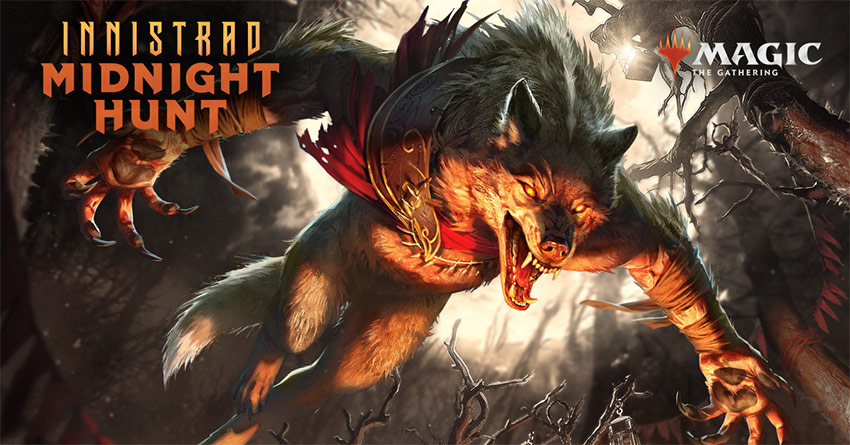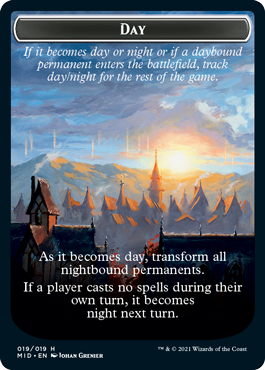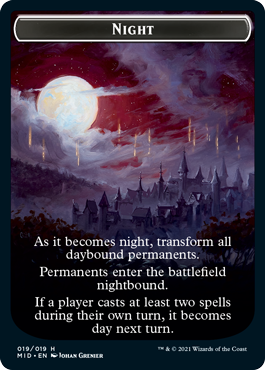Magic’s newest expansion has us returning to Innistrad just in time for Halloween. Innistrad: Midnight Hunt is the first of two expansions set in the horror-themed plane, and this first set sees the story focusing on the besieged humans’ attempt to reset the balance of day and night – something that has been thrown off ever since the events of Eldritch Moon. A returning set means returning mechanics, and we’ve got our share here, plus some new ones to ponder. In this article we’ll talk about the mechanics and offer some thoughts on what they mean for different formats and how they’ll play.
Double-Faced Cards (and Transform) Returns
It wouldn’t be Innistrad without the set’s signature mechanic, double-faced cards. The mechanic was first introduced with Werewolves back in Innistrad in 2011 and since then the mechanic has shown up regularly in sets every couple of years. Midnight Hunt sees the mechanic returning, but with some new twists, both for Werewolves and the non-Werewolf creatures in the set.
Daybound and Nightbound
This is the big new mechanic for transforming cards. Some double-faced cards have Daybound and Nightbound modes, and certain cards will set the game state to “Day” or “Night,” causing those cards to transform. The conditions for changing from day to night are the same as those for Werewolves in the original Innistrad, though the old cards don’t gain the daybound/nightbound rules text, they just happen to sync up the same way with permanents in play after a turn or two at most.
If it’s day as a turn begins, and the previous turn’s active player didn’t cast a spell last turn, it becomes night. Similarly, if it’s night as a turn begins, if the previous turn’s active player cast two or more spells last turn, it becomes day.
Pseudanonymous: I think it makes a lot of sense, for werewolves and such, and because they can provide rules clarifications on the day/night tracking card it lets them put more rules text onto creatures because they’ve essentially offloaded daybound/nightbound off the cards.
As it becomes day, all double-faced cards with nightbound transform to their daybound faces. As it becomes night, all double-faced cards with daybound transform to their nightbound faces. In other words, these double-faced cards should always be in sync, no matter who controls them. What’s more, permanents with daybound and nightbound can’t transform any other way.
As far as the impact of it goes, it seems like there’s probably a deck to be built around flip-flopping the day-night cycle. Brimstone Vandal, Gavony Dawnguard, and Sunrise Cavalier, Firmament Sage, and Obsessive Astronomer all have powerful effects triggered on the transition from day to night or night to day.
These cards are isolated to Jeskai colors, but of course these are just the triggered effects where you’d want to artificially flip flop back and forth actively. I think there’s an argument to be made for a control deck to be made here, where you just don’t cast anything on your turn and then hopefully your opponent tries to drop more than 1 spell. There’s also The Celestus, to force the change, but since it can only be operated at sorcery speed, it’s not as if you can do this on other players turns. In theory, if you stacked up 4 Component Collectors you could untap 3 mana rocks and The Celestus and make it flip flop over and over.
On the one hand, I think it’s a bit of a ham-fisted mechanic, and of course, it’s more shit hanging out around the command zone, we’ve now got:
- The Monarch
- The City’s Blessing
- Dungeons
- Day and Night
But these mechanics aren’t really strong enough for eternal formats, so the truth is you won’t see them interacting much. In terms of tracking transformations and having them make some sort of sense, this is much cleaner and more straightforward than past mass transformation mechanics. They vary thematically from the quest type transformations where you have to assemble some things and the personal growth style that some creatures take to become planeswalkers. I’m a bit puzzled they didn’t link it to the moon instead of day/night. It also opens the door up for seasons, though obviously winter seems a bit tied to the idea of snow permanents.
In commander I guess it would be kind of fun to try to make a deck around Day/Night, if Vadrik, Astral Archmage had white in his color identity it would be a lot more viable but he’s trapped in Izzet colors. I’ll probably do it anyway.
TheChirurgeon: I don’t love extra card cruft, but this does feel more like how werewolves should have been implemented initially. I do like how they’ve set this up to sync up, more or less, with the older werewolves, and I suspect players who’ve been out of Magic for a while but loved Innistrad will be able to pick this up pretty easily.
Dinglis: A nice mechanic overall I like the fact the tokens exist for the purpose of tracking it, a shame this didn’t come out in Innistrad 1 but overall I’m happy with it.
FromTheShire: Werewolves are one of the tribes that players have been clamoring for support for for years now, and after a somewhat disappointing showing in Shadows over Innistrad it seems like we’re getting a solid Commander in Tovolar, Dire Overlord that truly cares about the tribe and replaces Ulrich of the Krallenhorde or Ruric Thar at the helm of every existing Werewolf deck, and some good tribal support so players are no longer having to jam cards like Villagers of Estwald just to have a critical mass of creatures in their deck. I kinf of wish they had errata’d the existing Werewolf cards just to simplify things for newer players a little but that’s a minor gripe.
Disturb
Werewolves don’t get all the fun when it comes to transforming – Disturb is a new mechanic that’s primarily centered on the humans of Midnight Hunt, allowing you to cast them from your graveyard transformed for their disturbed cost. The transformed creatures are Spirits and will often be a significant upgrade on the original creature from a power level standpoint.


Pseudanonymous: This is kind of like if we spelled Embalm differently. But it includes a transform, so that’s pretty cool. I think it would be neat if you could sacrifice clue tokens to pay a disturb cost or something but maybe that’s a little meta. Otherwise, this basically functions as flashback with transform for creatures, and it’s pretty dope. Some of the transformations are quite good, and double dipping on your creatures is good, and being able to (and even wanting them to die) can be quite useful, chump block into a sacrifice effect generating triggers to get something back which generates even more triggers is a lot. Also Dennick is pretty nuts in a multiplayer environment. For say, Commander.
TheChirurgeon: As with Flashback, it’s really hard to create a mechanic that lets you get value out of a card twice that isn’t constructed playable in multiple formats.
Dinglis: Embalm is one of my favourite mechanics; it’s a nice supporting mechanic overall and leads to the kind of games I like in Standard (The Grindy Ones). I doubt many of the spoiled ones make Pioneer/Modern but a great mechanic for Standard for sure. As ever, Innistrad is a flavour homerun.
FromTheShire: This isn’t particularly splashy to me since we already have ways of doing very similar things, but nice nonetheless since I always dig graveyard strategies. Worth noting that unlike Embalm this isn’t a token, which has both advantages and drawbacks.
Coven
Coven is an ability word that describes abilities that trigger off having creatures with different powers. They generally follow the format: At time, if you control three or more creatures with different powers, then do something. But they may also “do something,” but only if you have three or more creatures with different powers. Or they may just give you a bonus for controlling three or more creatures with different powers.




Pseudanonymous: I think this is a pretty decently thought out mechanic. It’s fairly easy to achieve, but it does expose you to some risk. You have to have at least 3 creatures on the board to pull it off, this exposes you to asymmetrical board wipes and the like, and incentivizes your opponents to go heavy on creature control to keep you from having 3 creatures of different powers. It might also enable some hilarious tech plays where you are buffing your opponent’s creature in response to an activation or spell in order for them to have the same power, but it’s most likely to be creature control, especially given how much creature control there is in this set.
TheChirurgeon: This is a solid limited mechanic, since you’re often going to have a bunch of different creatures to work with and few duplicates. The hurdle of having three different creatures in a constructed format is probably too high a hurdle to clear most of the time, however.
Dinglis: I don’t really like mechanics that make people track things they feel clumsy and inelegant and are easy to miss with lords and pump effects. I don’t really like this kind of mechanic for constructed as it fairly easy to disrupt.
FromTheShire: Yeah I think this is mainly relevant for limited. It’s too easy to get blown out by removal in general constructed formats to count on, and the bonuses aren’t pushed enough to really matter for Commander.
Decayed
The new mechanic for Zombies is, on its own, a drawback – a creature with Decayed can’t block, and when it attacks, you sacrifice it at the end of combat. Where it ends up being an advantage is that Decayed typically either shows up on Zombie tokens you’ve created as extra value, such as on Diregraf Horde, which creates two 2/2 Zombies as an enters-the-battlefield effect (for a total of 7 power on 5 mana), or it’s added to creatures that are returned from the battlefield, as part of an effect that gives you extra value on creatures. So it ends up being a way of making certain effects – like Zombie tokens or recursion – cheaper or more efficient.

Pseudanonymous: I think this new zombie mechanic is really really neat. It makes temporary undead minions make some kind of sense, there are ways to get around it’s drawbacks, it causes mass sacrifices, they are still tokens… I like it a lot. I think it helps to bridge some of the gap between how truly gross token creation can get, and still make it playable without being out of control. I think in commander these will be really explosive, there are a lot of “When a creature dies” and “sacrifice a creature” and “when you sacrifice” effects, and the fact that you get these tokens a bit more efficiently means they will replace some of the older token generators like Sengir Autocrat. The fact they are zombies is also potentially useful for various triggers.
TheChirurgeon: Yeah I mean on its own the ability is whatever, but they’ve put it on quite a few very solid cards. It’s a great ability in limited and potentially constructed, if the format rewards playing aggressively.
Dinglis: A very tricky mechanic to evaluate overall. It’s hard to work out exactly how it will play out. It’s a mechanic that rewards attacking – I think it will be worse than the mechanic it is often compared to, which is Food, by a long way because Food has a lot more applications and synergy and plays better in both Midrange and Control whereas Decayed wants you to be attacking.
FromTheShire: I dig it as something that is stapled on to creatures or spells you already want to run. If you’re playing black and not taking advantage of your creatures dying then you’re doing it wrong, and the tokens basically come with a built in free sacrifice outlet. Zombie decks have a ton of ways to use the tokens, such as by making them into good attackers with lords like Death Baron, repeatable card draw with Cryptbreaker, or creating one sided wraths with Noxious Ghoul.
Other Returning Mechanics
A few other favorite Mechanics return in Midnight Hunt, the foremost (and most popular of them) being Flashback.
Flashback
Flashback is a powerful ability, essentially letting you replay a card from your graveyard for its Flashback cost. We’ve seen it before and it’s powerful. It’s good. It’s especially good if there are bonuses you can get for casting spells from your graveyard or casting a spell for its Flashback cost. Flashback is a player favorite for a reason. The one thing about Flashback is that you need to be a little more mindful of your opponent’s graveyard when Flashback spells end up there.

Dinglis: Reprint Mystical Teachings, you cowards! Or Think Twice. I love Flashback, it’s a sweet mechanic and rewards you for just playing the game which is an awesome place to be. Always happy to see this return.
FromTheShire: There’s a reason this mechanic routinely sees constructed play, and that’s because it’s good as hell.
Curses
More of a flavor favorite than a competitive darling, Curses are also back. These Aura Enchantments enchant players with some negative effect.
Pseudanonymous: Curses are… definitely back. They are here. They do what they do. Most of them I don’t see impacting Commander much, though there is a curse commander, so obviously a way to make your LGS or friends hate you is to play that curse commander.
TheChirurgeon: We called those cards “friend makers.”
Dinglis: Its a “no” from me sadly. Curses are sweet but just don’t make it as they very rarely impact the board sadly.
FromTheShire: Oh hey, it’s me the casual and group slug player, and I am stoked to get more Curses to add to our arsenal. Curses aren’t GOOD but they are FUN AS HELL. I’m not actually sold on Lynde, Cheerful Tormentor because she’s a bit slow for an already slow deck and she limits you to Grixis when there are some white cards you really want to include in your deck, but as one of the 99 absolutely.
Investigate
Investigate, first introduced in Shadows Over Innistrad, is also back. When you Investigate, you create a colorless Clue artifact token that has “2, Sacrifice this: Draw a card.” We’ve seen it show up sparingly in a few other non-Standard Legal sets since it was created. It only shows up on a few cards in Midnight Hunt, so it’s not really a major mechanic.
Pseudanonymous: Presumably a lot of investigate cards got pushed to the next set?
Dinglis: Reprint Tireless Tracker… (Oh wait, I’ve used that one). But yeah I love Investigate. One of the strong things about Innistrad is that it often features mechanics that reward you for playing the game. Investigate is always sweet and one of my favourite one-offs in constructed was Confirm Suspicions. Tireless Tracker also has a special place on my heart. This is really a mechanic I’d love to see used much more.
Next Time: The Set’s Monocolor Cards
That wraps up our look at the mechanics of Midnight Hunt. Tomorrow we’ll be back, looking at the most noteworthy cards in the set, starting with the monocolor cards in the main set, then in the following article we’ll cover multicolor, colorless, and double-faced cards before moving on to the set’s Commander decks. As always, if you have any questions or feedback, drop us a note in the comments below or email us at contact@goonhammer.com.




